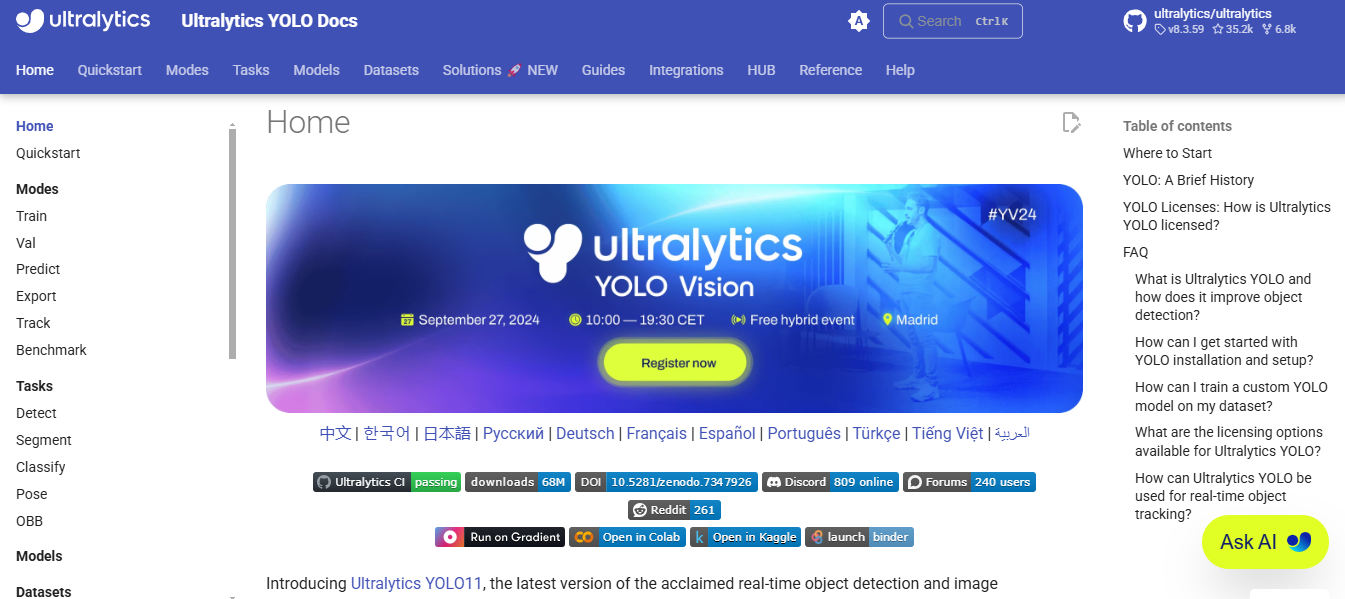This page has moved. If you are not redirected, click here.
YOLO: Evolution, Applications, and Current Trends in Object Detection
YOLO (You Only Look Once) has transformed from a groundbreaking concept to an industry standard in object detection since its inception in 2015. Initially developed by Joseph Redmon and Ali Farhadi at the University of Washington, YOLO gained popularity for its unprecedented speed and accuracy.
The evolution timeline showcases significant improvements:
- YOLOv2 (2016): Introduced batch normalization and anchor boxes
- YOLOv3 (2018): Enhanced backbone network and spatial pyramid pooling
- YOLOv4 (2020): Added Mosaic data augmentation and new loss functions
- YOLOv5: Brought hyperparameter optimization and experiment tracking
- YOLOv6-8: Expanded capabilities across multiple vision AI tasks
- YOLOv9: Implemented Programmable Gradient Information
- YOLOv10: Introduced End-to-End head eliminating NMS requirements
- YOLO11: Latest version offering state-of-the-art performance
The YOLO-Ultralytics Connection
Historical Development
YOLO was originally created in 2015. Ultralytics, led by Glenn Jocher, later became involved with YOLO development, creating YOLOv5 and subsequent versions including the recent YOLOv8 through YOLO11.

Current Status
Ultralytics maintains and develops proprietary versions of YOLO, with some key aspects:
- They provide the popular Ultralytics YOLO pip package and framework
- Their latest version is YOLO11, which includes advanced features like improved processing speed and new convolutional blocks
- The company offers both open-source and commercial versions of their YOLO implementations
Licensing Considerations
There’s an important distinction regarding usage rights:
- Earlier YOLO versions (v1-v4) have open licensing
- Ultralytics’ YOLO versions require either:
- Making applications open-source
- Purchasing an enterprise license for commercial use
Technical Contributions
Ultralytics has enhanced YOLO with several improvements:
- Created a unified framework supporting multiple YOLO architectures
- Developed user-friendly Python interfaces and CLI tools
- Added features like hyperparameter optimization and experiment tracking
- Integrated support for various export formats (ONNX, OpenVINO, CoreML)
The relationship between YOLO and Ultralytics represents a transformation from an academic project to a commercialized AI product, though this has sparked some controversy in the open-source community.
Real-World Applications
YOLO’s versatility has led to its adoption across numerous industries:
Manufacturing and Quality Control
- Defect detection on assembly lines
- Product inspection and quality assurance
- Surface inspection for anomalies
Agriculture and Environmental
- Crop monitoring and disease detection
- Pest identification
- Fruit counting with 90.83% accuracy
Security and Surveillance
- Real-time threat detection
- Suspicious activity monitoring
- Social distancing enforcement
Medical Applications
- Cancer detection
- Skin segmentation
- Pill identification
Automotive Industry
- Autonomous vehicle systems
- Traffic sign recognition
- License plate detection
Current Trends and Future Directions
The latest developments in YOLO technology showcase several exciting trends:
Technical Advancements
- Enhanced feature extraction capabilities
- Improved processing speed for real-time applications
- Better recognition of small and unusual objects
Integration Capabilities
- Seamless deployment across edge devices and cloud platforms
- Integration with robotics systems
- Enhanced multi-task learning capabilities
Industry Focus
- Expanding applications in precision agriculture
- Enhanced medical imaging capabilities
- Advanced surveillance systems
YOLO continues to evolve, with each new version bringing improvements in speed, accuracy, and versatility. Its open-source nature and growing community support ensure ongoing innovation and development in object detection technology.
References
- Redmon, J., & Farhadi, A. (2015). You Only Look Once: Unified, Real-Time Object Detection
- Ultralytics Documentation (2023). YOLO: Real-Time Object Detection
- Jocher, G. et al. (2023). YOLOv8: A State-of-the-Art Object Detection Model
- Wang, X. et al. (2022). Applications of YOLO in Agricultural Systems
- Zhang, H. et al. (2023). Recent Advances in YOLO Object Detection